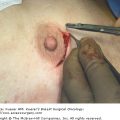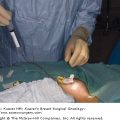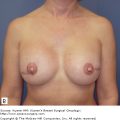Among postoperative therapies for early breast cancer, endocrine therapy is responsible for the greatest reduction in the risk of recurrence and death. Following resection of hormone receptor–positive breast cancer, adjuvant endocrine therapy reduces the risk of local recurrence, distant metastasis, and contralateral breast cancer. Currently new medical oncology treatments described as targeted therapies are improving outcomes in a variety of malignancies. Tamoxifen treatment for breast cancer represents the first successful application of a targeted therapy, where the drug targets the estrogen receptor (ER) on any residual tumor cells. Tamoxifen is described as a selective estrogen receptor modulator (SERM) because of its varying effects in different tissues, where it may act as an antagonist (eg, breast) or an agonist (eg, uterus).
The most recent Early Breast Cancer Trialists’ Collaborative Group (EBCTCG) Oxford overview analysis was published in 2005. This analysis found that among women with ER-positive tumors who were randomized to receive 5 years of adjuvant tamoxifen, the annual breast cancer recurrence rate was almost halved (41% proportional risk reduction) and the breast cancer mortality rate was reduced by one-third (34% proportional risk reduction) compared with those who did not receive tamoxifen.1 These benefits were observed across all age groups, regardless of the use of chemotherapy, and in both node-negative and node-positive disease. While the relative (proportional) risk reduction is similar for these different patient groups with ER-positive tumors, the absolute benefit from treatment with tamoxifen is greater for women at higher risk for relapse (Table 86-1).
| Absolute Difference in Recurrence at 10 Years* | Absolute Difference in Mortality at 10 Years* | |
|---|---|---|
| Node-positive breast cancer | ∼15% | ∼12% |
| Node-negative breast cancer | ∼12% | ∼5% |
The EBCTCG overview analysis also shows that for women who were randomized to receive adjuvant tamoxifen for 5 years, there is evidence of a protective carry-over effect with continued divergence of the risk of recurrence curves after tamoxifen treatment has been ceased during years 6 to 10. The mortality curves for patients treated with and without tamoxifen continue to diverge with 15 years of follow-up, indicating that the benefits are substantial and persistent. In women with ER-positive disease, adjuvant tamoxifen also reduces the risk of contralateral breast cancer by about one-third.
Recurrences after surgery for early breast cancer are not confined to the first 5 years, and this is particularly true for hormone receptor–positive breast cancer. For hormone receptor– negative breast cancer, recurrences occur predominantly during the first 5 years after surgery, whereas for hormone receptor–positive breast cancer there remains a significant ongoing risk of recurrence during years 6 to 15 after surgery, in addition to the risk of a second primary breast cancer. The EBCTCG overview data show that for women with ER-positive tumors who receive adjuvant tamoxifen, there are as many recurrences in years 6 to 15 as there are during the first 5 years after surgery.1 Appreciation of the prolonged time course after surgery in which recurrences of hormone receptor–positive breast cancer occur, has led to more research on the role of extended endocrine therapy.
To achieve optimal outcomes in early breast cancer, accurate assessment of tumor hormone receptor status is crucial, so that all patients who may benefit from endocrine therapy are identified. One recent study has suggested that when immunohistochemical methods are used, assaying core biopsies may provide more reliable ER and PR (progesterone receptor) estimations than assaying the excised tumor.2 To optimize the likelihood of detecting the presence of hormone receptors, it may be preferable to routinely assay core biopsies of invasive breast cancer for hormone receptors. However when significant hormone receptor staining is not detected in the initial core biopsy, it may still be reasonable to assay the resected tumor for hormone receptors, in case of a false-negative result with the prior testing or heterogeneity of the tumor.
Adjuvant endocrine therapy should be considered for all women with tumors that show any level of expression of ER or PR. Approximately 75% of breast cancers fall into this category. In endocrine therapy trials, hormone receptor–positive breast cancer is generally defined as tumors with 10% or more cells staining positively by immunohistochemistry for ER and/or PR. However, patients with tumors that show occasional cells (ie, 1%-9% cells) staining positively for ER or PR may derive benefit from endocrine therapy.3 Therefore while endocrine therapy should not be relied upon as the sole systemic therapy for these tumors, it should be included as part of the therapy. Endocrine therapy is not recommended for women with tumors with completely absent ER and PR hormone receptor staining (0% cells positive), with the exception of possible prophylaxis against second tumors in BRCA1 or BRAC2 gene carriers.4
Hormonal therapy with tamoxifen 20 mg orally daily is considered a standard component of adjuvant systemic therapy for premenopausal women with tumors expressing ER or PR hormone receptors, regardless of age or nodal status. Other than tamoxifen, there are no data on the use of other SERMs such as raloxifene or toremifene in the adjuvant setting in premenopausal women. In women with tumors with completely absent hormone receptor staining (0% cells positive) for ER and PR, adjuvant tamoxifen may be detrimental.5 The EBCTCG overview shows that 5 years of therapy is significantly more effective than 1 to 2 years of tamoxifen.1 Currently, 5 years of adjuvant tamoxifen is considered standard therapy for premenopausal women, however the optimal duration for adjuvant tamoxifen remains uncertain.
The large randomized ATLAS (Adjuvant Tamoxifen Longer Against Shorter) trial tested a longer duration of adjuvant therapy with tamoxifen and a preliminary presentation of the trial results reported a reduction in breast cancer recurrences with 10 years of tamoxifen compared with 5 years but with no significant effect on mortality.6 Results specific for premenopausal women were not presented, although the effect was reported to be similar across age groups. The aTTom (adjuvant Tamoxifen—To offer more?) trial similarly randomized women to an additional 5 years of tamoxifen versus ceasing hormonal therapy after at least 4 years of adjuvant tamoxifen. A preliminary presentation of the aTTom trial results showed a nonsignificant reduction in recurrence rates for women randomized to continue tamoxifen in years 5 to 10.7 Detailed publication of the aTTom and ATLAS trial results and/or longer follow-up may clarify the clinical relevance of these results for women who remain premenopausal after 5 years of tamoxifen. Given the survival advantage observed in postmenopausal women with node-positive tumors who receive extended hormonal therapy during years 6 to 10,8 duration of endocrine therapy is an important question for younger women.
Tamoxifen is effective regardless of menstrual status, while aromatase inhibitors are only effective in postmenopausal women. Tamoxifen may result in infrequent menses or prolonged amenorrhea in women who biochemically remain premenopausal. In women under 50 years of age, prolonged amenorrhea on tamoxifen may lead to the false conclusion that a woman is postmenopausal if confirmatory biochemical verification of the estradiol level is not undertaken. Tamoxifen was initially used as a fertility treatment and women of childbearing potential receiving tamoxifen should be informed that they may become pregnant, even if not menstruating. As tamoxifen may harm a developing fetus, women receiving tamoxifen should be advised to utilize nonhormonal methods to avoid pregnancy. In some clinical situations, women may elect to cease tamoxifen prior to completing 5 years because of a desire for pregnancy.
HER-2 overexpression in breast tumors is associated with an adverse prognosis and an increased risk for early relapse. There are data from preclinical studies, metastatic disease, and the adjuvant setting9-11 to indicate that the presence of HER-2 overexpression may be associated with tamoxifen resistance in hormone receptor–positive breast cancer. Currently it is recommended that tamoxifen be included in the adjuvant therapy for premenopausal women with hormone receptor–positive tumors with associated HER-2 overexpression, although additional adjuvant therapies such as chemotherapy and trastuzumab (Herceptin) may be more important in this patient subset.
Ovarian function suppression refers to the reversible induction of menopause with temporary cessation of ovarian estrogen production in premenopausal women by regular injections of gonadotropin-releasing hormone (GnRH) agonists, also known as luteinizing hormone-releasing hormone (LHRH) agonists. Generally GnRH injections are administered on a 4 weekly (monthly) schedule. Depot GnRH agonist preparations administered every 3 months are available, although there has been some uncertainty about the adequacy of suppression in women with the less frequent administration schedule. Even with the monthly injection schedule, GnRH agonists may not achieve complete ovarian function suppression in some patients,12 and pregnancy has occasionally been reported in women receiving GnRH therapy. The possibility of incomplete ovarian function suppression in premenopausal women with GnRH agonists is particularly relevant if an aromatase inhibitor is given in combination and the efficacy of this adjuvant therapeutic approach in premenopausal women is currently being tested in clinical trials. The Austrian Breast and Colorectal Cancer Study Group adjuvant ABCSG-12 trial randomized premenopausal women with hormone-responsive breast cancer to receive 3 years of ovarian suppression (by GnRH) plus either tamoxifen or anastrozole. The women in ABCSG-12 were additionally randomized to either receive zolendronic acid (a bisphosphonate) or not. In a preliminary presentation of the results there was no significant difference in outcome between patients receiving tamoxifen or anastrozole.13 The ABCSG-12 trial was possibly underpowered to definitively answer this question, which is also being studied in the larger ongoing Tamoxifen and Exemestane Trial (TEXT) and Suppression of Ovarian Function Trial (SOFT) randomized adjuvant trials.14
Ovarian ablation refers to the permanent induction of menopause with permanent cessation of ovarian estrogen production in premenopausal women by either surgical oophorectomy or ovarian irradiation. Surgical oophorectomy may be performed by laparoscopic surgery or laparotomy. Ovarian irradiation is not generally favored as a method of ovarian ablation due to the quick recovery from laparoscopic oophorectomy, potential for unsuccessful ovarian ablation with irradiation, and the concern that radiation of healthy tissues may result in long-term or late toxicity. If ovarian irradiation is performed as a method of ovarian ablation, hormone levels should be subsequently checked, to ensure that estradiol has fallen to a postmenopausal level.
In premenopausal women with hormone receptor–positive breast cancer, ovarian suppression (by GnRH agonists) and ovarian ablation are effective adjuvant endocrine treatments.1 There is no evidence that ovarian suppression or ablation is more effective than tamoxifen. Adjuvant endocrine therapy by means of ovarian suppression or ablation has been shown to provide a similar benefit to adjuvant chemotherapy with the CMF (cyclophosphamide, methotrexate, and 5-fluorouracil) first-generation chemotherapy regimen.15 Ovarian suppression or ablation is considered a valid alternative to chemotherapy in premenopausal women with early breast cancer who are appropriately selected for endocrine responsiveness and without other high-risk features.16 Tumors most suited to this therapeutic approach (1) exhibit strong staining for both ER and PR in the majority of cells, (2) are HER-2 negative, and (3) have no or limited nodal involvement. For women over 40 years of age, when reversibility of menopause is not desired, surgical ovarian ablation may be a better alternative to ovarian suppression by GnRH agonists. In younger women, ovarian suppression by GnRH agonists is more commonly favored, as temporary induction of menopause may reduce the long-term effects associated with permanent premature menopause. The optimal duration of ovarian function suppression adjuvant therapy is uncertain, although 2 years of therapy could be considered as a minimum duration. Trials have generally utilized between 2 and 5 years of GnRH therapy. Given that longer durations of oral hormonal adjuvant therapy are more effective than 2 years, it seems plausible that longer durations of ovarian function suppression may also be more effective.
When ovarian suppression or ablation therapy is chosen as an alternative to adjuvant chemotherapy in premenopausal women, it is ordinarily combined with tamoxifen. There is evidence that adding 5 years of tamoxifen to GnRH agonist therapy provides additional benefit.17 By contrast, for premenopausal women who receive 5 years of adjuvant tamoxifen either with or without prior adjuvant chemotherapy, there is no clear evidence that adding ovarian suppression or ablation provides significant additional risk reduction, over and above that achieved by tamoxifen. This question is currently being studied in the randomized Suppression of Ovarian Function Trial (SOFT). As many premenopausal women become postmenopausal after adjuvant chemotherapy, any potential additive effect of ovarian ablation is likely to be observed predominantly in younger women or those who retain ovarian function. While there are concerns regarding the potential for resistance to tamoxifen in the subset with hormone receptor–positive breast cancer plus HER-2 overexpression, a combined endocrine approach with ovarian ablation plus tamoxifen was found to be an effective adjuvant strategy in this patient subset in a premenopausal trial.18
In premenopausal women with hormone receptor–positive breast cancer, chemotherapy reduces the risk of recurrence through direct cytotoxic effects but may also have indirect endocrine effects. Chemotherapy may result in transient ovarian function suppression clinically manifested by temporary amenorrhea or permanent ovarian function suppression with menopause. Premenopausal women with hormone receptor–positive breast cancer who experience amenorrhea for at least 3 months following adjuvant chemotherapy have been found to have a reduced risk of recurrence compared to those who continue to menstruate.5,19 Women with chemotherapy-induced amenorrhea and experiencing menopausal symptoms may find this information encouraging. The likelihood of undergoing permanent menopause following adjuvant chemotherapy is both age and regimen dependent, with virtually no women under the age of 30 years experiencing permanent amenorrhea and a minority in their 30s.20 Shorter adjuvant chemotherapy regimens completed within 3 months are associated with a lower probability of amenorrhea than 6 to 8 cycle regimens administered over 4 to 6 months.
Women who experience chemotherapy-induced amenorrhea should not receive adjuvant endocrine therapy with an aromatase inhibitor alone as the likelihood of ovarian recovery is significant, particularly among those under 40 years old. Even for women in their 40s who have chemotherapy-induced amenorrhea with biochemical confirmation of postmenopausal estradiol, caution should be taken with commencement of an aromatase inhibitor. In one study, among 45 such women with a median age of 47 (range, 39-52 years), 12 women (27%) had recovery of ovarian function on the aromatase inhibitor.21 It is feasible that the ovarian function recovery was actually stimulated by the aromatase inhibitor in these women, given that aromatase inhibitors are currently being utilized to induce ovulation for in vitro fertilization (IVF) programs. It should be noted that in a previously premenopausal woman, a single measurement of hormone (estradiol, FSH, and LH) levels showing postmenopausal levels after chemotherapy does not predict the potential for recovery of ovarian function. The potential for recovery of ovarian function is greater with shorter adjuvant chemotherapy regimens, compared with 6-month regimens that include oral cyclophosphamide. Tamoxifen is a more reliable option for women with chemotherapy-induced amenorrhea, unless serial monitoring of hormone levels is planned.
Current American Society of Clinical Oncology (ASCO) guidelines recommend that an aromatase inhibitor should be included as a component of adjuvant endocrine therapy for postmenopausal women, either initially or after a course of tamoxifen.22 However tamoxifen remains an effective adjuvant therapy for postmenopausal women. Five years of adjuvant endocrine therapy with tamoxifen is the gold standard against which newer endocrine therapies have been compared. Therapy with tamoxifen alone may be an appropriate choice for women in whom aromatase inhibitors are poorly tolerated, contraindicated, or for women with low-risk tumors when the toxicity profile of tamoxifen is deemed preferable to the toxicity profile of aromatase inhibitors for that individual. Currently for most postmenopausal patients who are commenced on tamoxifen, consideration may be given to a switch to an aromatase inhibitor after an initial ∼2 years of tamoxifen. In postmenopausal women who receive initial tamoxifen, if this hormonal therapy is poorly tolerated, then an earlier switch to an aromatase inhibitor should be considered.
It should be noted that the increased risk for the serious toxicities associated with tamoxifen such as endometrial tumors and thromboembolism predominantly occurs in postmenopausal women. In postmenopausal women with a prior history of thrombosis, initial treatment with an aromatase inhibitor may be a safer option. For women considered at higher risk for early recurrence, an aromatase inhibitor is generally chosen instead of tamoxifen for the commencement of endocrine therapy. In the Breast International Group (BIG) 1-98 trial, factors associated with an increased risk of early recurrence include nodal positivity (particularly 4 or more positive nodes), HER-2 overexpression, only 1 hormone receptor–positive, high-grade tumor, large tumor size, and vascular invasion.23
The International Breast Cancer Study Group conducted 2 randomized trials (IBCSG 12 and 14) in node-positive postmenopausal women comparing 5 years of adjuvant endocrine therapy with tamoxifen 20 mg orally daily with toremifene 60 mg orally daily. Analysis of these trials showed that toremifene resulted in similar outcomes to tamoxifen (ie, not significantly different) as an adjuvant endocrine therapy for this patient population and was an acceptable alternative.24 The 5-year disease-free survival was 72% and 69% for toremifene and tamoxifen, respectively. The 5-year overall survival rates were 85% and 81%, respectively.
Prior to menopause, estrogen is predominantly produced by the ovaries, but after menopause estrogen is predominantly produced in adipose tissue by the enzyme aromatase. Aromatase inhibitors act to reduce the already low estrogen levels in postmenopausal women by blocking the conversion of precursor hormones to estrogen in adipose tissue. If a patient is receiving an aromatase inhibitor, then hormone-replacement therapy is contraindicated. There are currently 3 third-generation aromatase inhibitors (AIs) in clinical practice that have been shown to improve outcomes compared with 5 years of tamoxifen for postmenopausal women with hormone receptor–positive breast cancer. These agents are anastrozole (Arimidex), letrozole (Femara), and exemestane (Aromasin). There are 3 ways of utilizing aromatase inhibitors that have been shown to be effective in adjuvant endocrine therapy for postmenopausal women (Table 86-2).
Stay updated, free articles. Join our Telegram channel

Full access? Get Clinical Tree







